I have to admit, I was a bit skeptical when I first saw this game online. The advertisement went on to describe how players would be picking various races throughout the game in an attempt to get the most points in the end. Territories that you conquered could be wiped out by another player who decided to start with a new race and a fresh hefty stack of army tokens…it seemed a bit too chaotic for my blood. Then, out of the blue, one of my friends recommended this game to me seeing as how I was covering a ton of board games on my blog. This good friend of mine, let’s call him “Booyah!” (his name was changed to protect the innocent), said that the game was a lot of fun once you get used to the racial abilities. “Booyah!” has never steered me wrong before…so I took a chance and bought the game. I’m glad I did.
Small World is a competitive fantasy game where players will be maneuvering for control over land on the board in an attempt to score victory points. This land could be in the form of hills, mountains, farmland…etc. The type of land players conquer becomes important when racial bonuses are considered during scoring, more on that in a bit.
A Word On How Races Work
New players will notice straight away that there are a plethora of racial cards and army tokens. Coupled with them are separate bonus modifier cards that fit right into the groove of the racial cards. Before the game begins, there will be a pool of six racial cards that will be laid out vertically. Beside those six racial cards will be six random bonus modifiers, one for each race. These modifiers change the way these races may act or score, making the game highly replayable. You never know whether or not you’ll see Diplomatic Skeletons as opposed to say, Dragon Master Skeletons or Merchant Skeletons.
Players are limited to one active race at a time. Players will initially choose one of those six races and receive their respective army tokens. The racial cards and their bonuses shift upwards and a new random race / bonus card is placed at the very bottom of the pool. To discourage players from neglecting one particularly bad race / bonus combination, players will have to pay one victory point per race as they go down the pool. The race on the top is free. If you wanted the new race on the very bottom, you’d have to place a victory point token on each race until you got to it. After a while, those unappealing races that have been sitting there collecting victory points suddenly don’t look so bad.
As your army tokens get defeated and removed from the board in battle, you’ll find that you’ll be limited to how many tokens you can conquer with. There comes a point where you just aren’t getting the most out of your army anymore and thus can place that race into “decline.” All army tokens are flipped over to the “decline” side and can’t be used to conquer (Ghouls are the exception) other lands but remain and collect victory points for you until they are conquered. At the beginning of your next turn, you can select a new race from the pool and begin conquering lands all over again with your fresh pool of army tokens from that new race. The player that best makes use of the race they select along with their bonuses will usually be the winner. You wouldn’t leave Orcs with the Pillaging bonus at home playing the waiting game, for example, as they will both receive a separate bonus for conquering a land with another race in it.
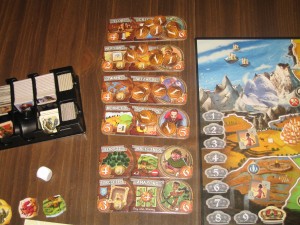
In this example, the race at the very top is not only free, but the player who claims it gets six victory points.
Game Setup
There are two separate game boards that come with the game and they are both double-sided. Each side is for a specific number of players. The more players, the larger the map. Players place the correct board in the middle of the table and draw six random races and bonuses for the pool. Mountain tokens are placed on the mountain spaces of the board and the lost civilization tokens are placed on their preset positions. These lost civilization tokens represent remnants of an old civilization that are dying out but still needs to be conquered. Each player receives five victory point tokens, mainly so that they can initially “pay” for a race further down the pool should they wish to. The crown token goes on the “1″ on the game turn track. The crown advances on the track when everyone has taken a turn. Once the track reaches “10″, players take a final turn and the game is over.
The First Turn
On a player’s first turn, they’ll pay for a race, receive the appropriate amount of army tokens (racial + bonus numbers on the cards), and begin conquering lands starting from any land that borders the edge of the board. It takes two army tokens to conquer an empty space. For every extra feature on that space, such as a mountain, lost civilization, or enemy army token, it takes that many extra army tokens to conquer it. A mountain space with an enemy token on it, for example, would require four of your tokens to conquer…two for the space, one for the mountain, and one for the enemy army token. If, on your last troop placement, you don’t have enough to conquer an adjacent land, you can gamble and roll a reinforcement die. If the number on the die plus your army size is equal to or more than you need, you get to conquer that land. If you fail at the roll, you simply place the remaining troops on a space you’ve already conquered. You do not add new troops from the box should you win…your reinforcements are “invisible” and only serve to resolve whether or not your remaining army token(s) get to conquer that final space.
After players are finished conquering, they can re-organize their troop tokens among the lands they’ve conquered, and then scoring occurs. Players score a point for every land they conquer plus whatever bonuses they receive from their racial and bonus cards. Smart players will try to conquer lands that compliment the bonuses on their cards.
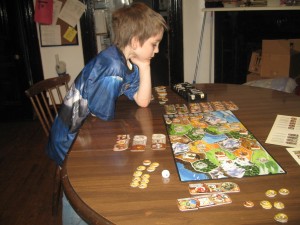
Players may want to spend a moment looking at what all of the races do to help them decide which race would be best for the situation brewing on the board.
After The First Turn
Players will now have their tokens clustered around the board at this point. From here, gameplay can be summarized as follows:
1) Mobilize Troops: Pick up any army tokens you wish from the lands you’ve conquered and begin conquering lands all over again.
2) Score Victory Points: Score points based on the number of lands you’ve conquered plus racial / bonus cards bonuses.
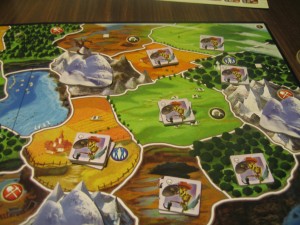
My son’s Hill Skeletons netted him nine points at the end of his turn…seven for the spaces and two for the hills that he occupied.
Conquering Lands Occupied By Another Race
When conquering lands occupied by another race, you’ll need two army tokens plus however many there are enemy army tokens. If you conquer a land with only one enemy army token in it, it goes off the board forever. If you conquer a land with more than one enemy army token on it, one goes off the board forever and the rest can be seeded by the defeated player among their lands at the end of the current player’s turn.
Placing Races Into Decline
After a while, races will lose army tokens as a result of being attacked and conquered. When a player feels that their race is no longer efficient, they can place their race into “decline”, losing any bonus abilities that the race has. They reduce their army size to one token per land that they have conquered and end their turn. Placing your race into decline must be done at the start of the turn, after which your turn immediately ends. On the player’s next turn, they can pick / buy a new race from the pool and begin conquering all over again.
The Review
That’s honestly all there is to it. Pick a race, conquer, score, conquer, score, conquer, score, go into decline, pick a new race, conquer, score, conquer, score…etc etc etc. There’s obviously more to it than that and some of the racial bonuses amend the above rules in various ways, but that is the general idea.
My sole complaint about the game is the tray that the army tokens came in. It did not match the picture shown in the instruction manual. The races with the most army tokens did not fit evenly into one slot. I was forced to place those extra tokens into another race’s slot…not a big deal for your average gamer but I’m a bit OCD about those kind of things. I bit my tongue and got over it, however.
I have to say, I really enjoyed this game, as did my son. The amount of possibilities a player has is vast, yet the overall gameplay is simple enough to where the player doesn’t feel overwhelmed. My son’s favorite part of the game, he says, was being able to pick different races throughout the game. While he often chose the races and bonuses that sounded “the coolest”, I could tell that he gave serious thought to how best to use them to score the most points. Even though I originally thought that the changes in race throughout the game would be too chaotic, I was happy to be proven wrong. It turns out that the ability to change races allows the game to turn in a complete 180, allowing players that are losing to pull ahead should they play their cards right. This mechanic keeps the board constantly changing, making play fun and exciting until the very last turn.
Those who might be intimidated by the number of races and special abilities should know that there are nice, handy player guides that summarize the abilities included in the game, sort of like a cheat sheet. Those just learning the game or playing it for the first time can expect to take a little longer in reviewing all of the available races in the pool, but that shouldn’t deter you from playing this excellent game.
Final Verdict: 8/10
—

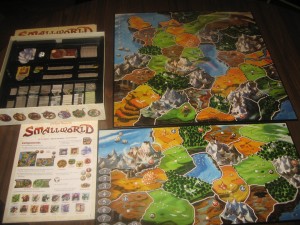
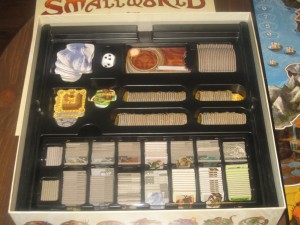
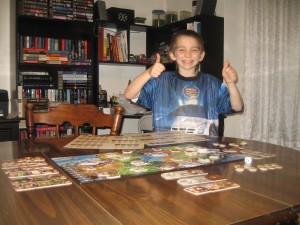
This is one of my favorite games to play. Glad you enjoy it too.